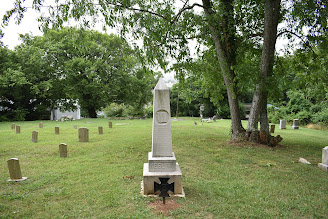A few weeks back, I took a little social distancing day trip down to Scott County and Bristol. I ended my day in Bristol’s East Hill Cemetery. As I said before, the monuments in some of these old cemeteries tell a story or at least tell enough of a story to make you want to know more about the person. That was the case as I walked around this historic cemetery.
As I was walking through the Civil War Section I came upon the grave with this inscription on the stone “The Southern Horatius – Successfully defend the bridge at Strawberry Plains, Tennessee on the Night of November 8, 1861.” This was enough to make me want to know more about James Keeling.So when I got back home, I did a little research and discovered that prior to the start of the Civil War
 |
| Add caption |
In 1861, the railroad hired Mr. Keeling to guard the bridge. He would work on the farm by day and sleep at the east end of the bridge during the night. On the night of November 8, 1861, about 40 Union Volunteers under the direction of Sevier County Sheriff William Pickens approach the bridge. They were going to burn the bridge, however they hadn’t count on encountering Keeling, who immediately shot and killed Pickens, who dropped the lit torch into the river below.
The others Union Volunteers charged Keeling who engaged his attackers in a hand to hand fight in which two more Union Volunteers were killed. During the hand to hand battle one of the Volunteers got a shot off, wounding Keeling. Thinking he was dead and not having any way to torch the bridge they rode away. Seriously wounded, Keeling walked to a nearby home and a doctor amputated his hand, which was buried in the Stringfield Family Cemetery.
After the war Keeling struggled to make a living and later moved to a small farm near Bristol where he was regard by Confederate Veterans as a hero and was a popular figure at Confederate Reunions. Veterans often referred to him as “The Horatius of the South,” after the legendary Roman Figure who had also defended a bridge. James Keeling died on February 12, 1895 and was buried in East Hill Cemetery. His grave was unmarked until about 1909, when local citizens raised the necessary funds to place and dedicated the marker that I visited today.

No comments:
Post a Comment